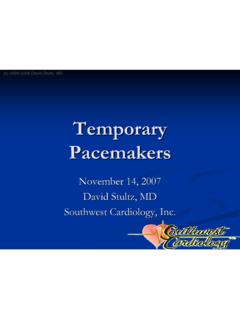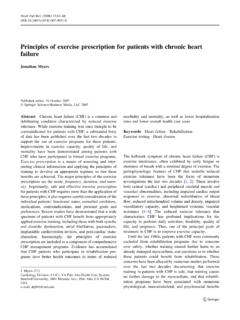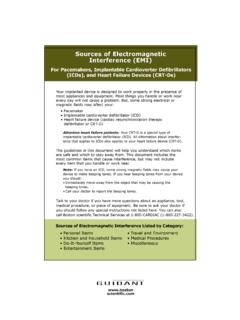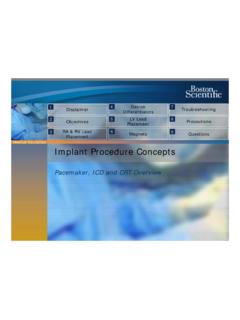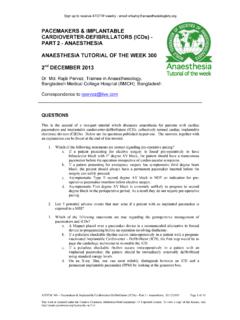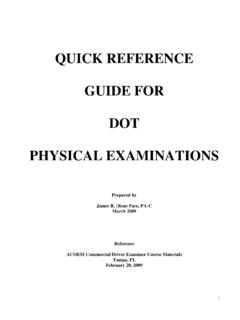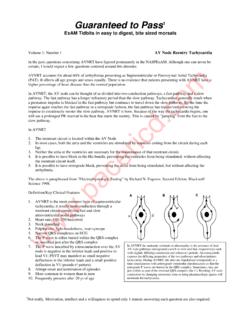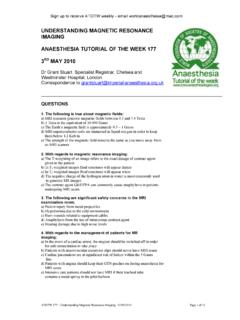Transcription of CDA Position on Antibiotic Prophylaxis for Dental …
1 CDA Position onAntibiotic Prophylaxis for Dental patients at Risk This information was created by the Canadian Dental Association for use by CDA member dentists. It should not be used as a replacement for professional Dental or medical advice. If you have questions about this Position statement, please consult your dentist or contact the Canadian Dental categories of invasive Dental treatment are known to produce significant bacteremias. Such bacteremias, although transient, may be detrimental to the health of patients with a variety of medically compromising conditions and pretreatment Antibiotic Prophylaxis may be indicated. Although the need to provide such chemoprophylaxis for patients with certain cardiac conditions is well known among Dental practitioners, there are many other medically compromising conditions for which Antibiotic Prophylaxis may be appropriate.
2 Antibiotic chemoprophylaxis prior to such Dental treatment is appropriate for these selected patients . These recommendations are based upon a variety of in vitro studies, clinical experience, animal model data and an assessment of the common oral flora most likely to cause potential bacteremias. Definitive patient risk/benefit ratios for these prophylactic procedures have not been determined nor have they been medically or scientifically proven to be effective by well-designed controlled human trials (with or without randomization). Dental procedures which may produce significant bacteremias include all procedures where significant oral bleeding and/or exposure to potentially contaminated tissue is anticipated. These procedures may include, but are not limited to, Dental extractions and other oral surgery, sub-gingival scaling and the sub-gingival placement of Dental dam clamps, restorations or orthodontic bands.
3 Such procedures would typically require Antibiotic Prophylaxis in patients at risk. Simple adjustment of orthodontic appliances, tooth brushing or spontaneous loss of primary teeth do not require Antibiotic Prophylaxis . patients at risk would include those with cardiac deformities, those with artificial devices in the circulatory system, and those with immunocompromising conditions (see Table 1). patients with cardiac deformities should receive Antibiotic Prophylaxis according to the current guidelines of the American Heart Association (see Table 2). Consultation with the patient s physician may be required. patients with artificial devices in the circulatory system should receive Antibiotic Prophylaxis using the current protocols of the American Heart Association.
4 Such patients would include, but not be limited to, those with heart valve replacement including bioprosthetic and homograft valves, recent surgical repairs of cardiovascular defects within the past six months, and indwelling shunts or conduits (such as patients with indwelling central lines or vascular access catheters, such as Port-a-caths, for cancer chemotherapy, ventriculoarterial or ventriculovenus shunts for hydrocephalus and arteriovenus shunts for hemodialysis). Consultation with the patient s physician may be required. CDA Position onAntibiotic Prophylaxis for Dental patients at RiskPage 2 of 6 This information was created by the Canadian Dental Association for use by CDA member dentists. It should not be used as a replacement for professional Dental or medical advice.
5 If you have questions about this Position statement, please consult your dentist or contact the Canadian Dental with a variety of immunocompromising conditions should receive Antibiotic Prophylaxis using the current protocols of the American Heart Association. Such patients would include, but not be limited to, those with a suppressed leukocyte count (such as cancer chemotherapy, AIDS, blood dyscrasias, transplant recipients) where the white blood cell count (WBC) is less than 3500 cells/mm3( K/mm3) or the absolute neutrophil count (ANC) is less than 500 cells/mm3( K/mm3). Consideration for Antibiotic Prophylaxis should be given for other patients with an impaired immune system or those with delayed healing, such as those with, but not limited to, previous radiation therapy where planned extractions or other bony surgery is in the radiation field, an ANC less than 1000 cells/mm3( K/mm3), uncontrolled diabetes, systemic lupus erythematosus and infection drug users.
6 Consideration should be given for longer Antibiotic Prophylaxis schedules (seven to ten days or longer) for those patients where delayed healing following invasive procedures would further expose them to ongoing bacteremias. Consultation with the patient s physician may be required. The CDA concurs with the Position of the American Dental Association regarding Antibiotic Prophylaxis for Dental patients with total joint replacement. In their advisory statement, the American Academy of Orthopaedic Surgeons and the American Dental Association have recommended the use of prophylactic antibiotics only for patients with total joint replacement (not for patients with only pins, screws, and/or plates), compromised immune system, Type I diabetes mellitus, recent (within two years) joint replacement, previous prosthetic joint infection, malnourishment or hemophilia.
7 Consultation with the patient s orthopedic surgeon may be required. Conditions which generally do not require Antibiotic Prophylaxis would include, but not be limited to, physiologic, functional or innocent murmurs, a history of rheumatic fever without residual clinical heart disease, uncomplicated secundum atrial septal defect, mitral valve prolapse without mitral insufficiency, regurgitation or a murmur, coronary artery stenosis, cardiac pacemakers, atherosclerotic heart disease, well-controlled diabetes, immunocompromising conditions without decreased WBC or ANC, sickle cell anemia, cystic fibrosis or other simple orthopedic metallic devices. Consultation with the patient s physician may be required. patients at risk requiring Antibiotic Prophylaxis who are already receiving an Antibiotic for a pre-existing condition should receive an Antibiotic for Prophylaxis from a different classification.
8 For example, a patient at risk already receiving penicillin for some other condition should receive another Antibiotic for Prophylaxis , such as clindamycin. patients at risk should establish and maintain the best possible oral health to reduce potential sources of bacterial infection. Every attempt should be made to reduce gingival inflammation in patients at risk by means of brushing, flossing, topical fluoride therapy, antimicrobial rinses and professional cleaning before proceeding with routine Dental treatment. CDA Position onAntibiotic Prophylaxis for Dental patients at RiskPage 3 of 6 This information was created by the Canadian Dental Association for use by CDA member dentists. It should not be used as a replacement for professional Dental or medical advice.
9 If you have questions about this Position statement, please consult your dentist or contact the Canadian Dental order to help prevent the development of resistant strains, antibiotics should not be used indiscriminately. Complications associated with the use of antibiotics include toxic and allergic reactions, superinfections and the development of resistant organisms. It is essential that practitioners be well informed about the actions and reactions of any drugs they prescribe or administer and be prepared to handle any reasonably foreseeable complication, including anaphylaxis. Health care professionals are ultimately responsible for their own treatment decisions. ApprovedCDA Board of DirectorsFebruary 2005 CDA Position onAntibiotic Prophylaxis for Dental patients at RiskPage 4 of 6 This information was created by the Canadian Dental Association for use by CDA member dentists.
10 It should not be used as a replacement for professional Dental or medical advice. If you have questions about this Position statement, please consult your dentist or contact the Canadian Dental 1 Antibiotic Prophylaxis FOR Dental patients AT RISKC onditions for which Antibiotic Prophylaxis is RECOMMENDED:Previous episode of infective bacterial endocarditisHeart valve replacement, including bioprosthetic and homograft valvesRecent surgical repair of cardiovascular defects within the past six monthsSurgical systemic to pulmonary artery shunts or conduitsRheumatic heart disease or other acquired heart diseaseMitral or aortic valvulitisHypertrophic cardiomyopathyCongenital heart disease:Ventricular septal defects (unrepaired)Patent ductus arteriosusCoarctation of the aortaTricuspid valve diseaseAsymmetric septal hypertrophyTetralogy of FallotAortic stenosisPulmonic stenosisComplex cyanotic heart diseaseSingle ventrical statesTransposition of the great arteriesBicuspid aortic valveIdiopathic hypertrophic subaortic stenosis (IHSS)Indwelling vascular catheter (such as Port-a-caths)Renal dialysis with arteriovenus shunt applianceMitral valve prolapse (MVP) with mitral insufficiency, regurgitation, thickened leaflets and/or holosystolic murmurPost-mitral valve surgeryVentriculoatrial (VA) shunts for hydrocephalusVentriculovenus (VV)
